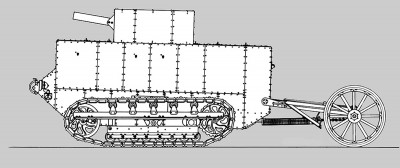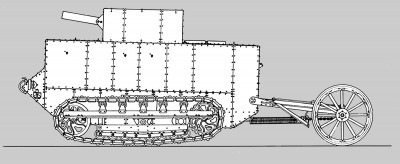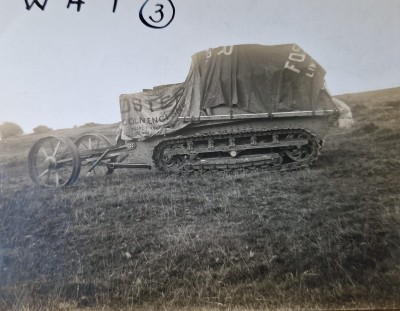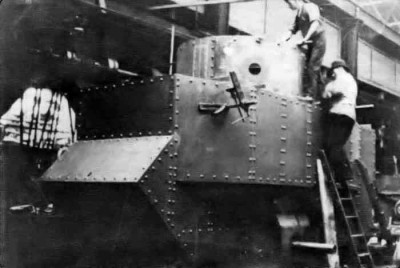The first vehicle designed to meet the requirements issued in the memorandum of 9 June 1915.
The Admiralty Landship Committee called for a speed of 4 mph (6.4 km/h), autonomy for 6 hours, the ability to cross a wall 5 ft (1.52 m) high with a 45° slope, and a trench 8 ft (2.44 m) wide.
The crew was to be six, and the armament was to consist of a light cannon and two machine guns. The armour was to protect against rifle shots and shrapnel.
Power was provided by a standard Foster-Daimler engine with a displacement of 13,000 cm3 and a power output of 78 kW, the power being transmitted via a conical clutch to a Foster two-speed gearbox and via a differential to a chassis fitted with Bullock tracks. This, with a total vehicle weight of 14,733 kg, was sufficient to achieve a speed of 3.5 mph (5.6 km/h).
Steering was possible by braking the differentials or by turning the two large steel steering wheels attached to the rear of the vehicle. The simple box-shaped hull carried a revolving turret with a mock-up of a 2-pounder (40 mm) gun on the ceiling plate. The vehicle crew consisted of 4-6 men.
Sources:
David Fletcher; British Mark I Tank 1916; Osprey New Vanguard 100 ISBN 1841766895
Jacek Stolarz; Czolgi Brytyjskie 1914-1918; Militaria 30
David Fletcher; The British Tanks 1915-1919; Crowood Press Ltd; ISBN 1861264003
The Admiralty Landship Committee called for a speed of 4 mph (6.4 km/h), autonomy for 6 hours, the ability to cross a wall 5 ft (1.52 m) high with a 45° slope, and a trench 8 ft (2.44 m) wide.
The crew was to be six, and the armament was to consist of a light cannon and two machine guns. The armour was to protect against rifle shots and shrapnel.
Power was provided by a standard Foster-Daimler engine with a displacement of 13,000 cm3 and a power output of 78 kW, the power being transmitted via a conical clutch to a Foster two-speed gearbox and via a differential to a chassis fitted with Bullock tracks. This, with a total vehicle weight of 14,733 kg, was sufficient to achieve a speed of 3.5 mph (5.6 km/h).
Steering was possible by braking the differentials or by turning the two large steel steering wheels attached to the rear of the vehicle. The simple box-shaped hull carried a revolving turret with a mock-up of a 2-pounder (40 mm) gun on the ceiling plate. The vehicle crew consisted of 4-6 men.
Sources:
David Fletcher; British Mark I Tank 1916; Osprey New Vanguard 100 ISBN 1841766895
Jacek Stolarz; Czolgi Brytyjskie 1914-1918; Militaria 30
David Fletcher; The British Tanks 1915-1919; Crowood Press Ltd; ISBN 1861264003



